An earthen church vessel: Gabriel Chaile & Laura Ojeda Bär
recessed.space visited Studio Voltaire gallery in London a few days before the opening of a major new exhibitions by Argentinian artist Gabriel Chaile, who had invited painter Laura Ojeda Bär to share his exhibition. An artist who uses earth clay to create anthropomorphic oven-like vessels drawing from South American ethnography & craft, here the artist has used the material to convert the gallery into an entirely new architectural environment, as seen by Will Jennings & photographed by Carlo Zambon.
Two days before the opening of an exhibition and gallery is
normally a pristine place. Polished floors, freshly painted white walls bar
perhaps a few pencil marks as the last frames are being precisely lifted into
place, and vinyl ready to be applied as the final touch.
At Studio Voltaire, south London, the scene is somewhat different. The main gallery space, a former Victorian Methodist church, is caked in mud – some of it dry, across most of the walls and splashed across roof timbers and the windows, but much of it wet, including lumpy masses filling enormous tubs. A temporary cover protects the polished concrete floor, while ladders and scaffolding give the space more an appearance of a building site than an imminent exhibition of work by artists Gabriel Chaile and Laura Ojeda Bär.
![]()
![]()
![]()
![]()
For the last month Lisbon-based Argentinian Chaile has been reimagining the space, transforming its ecclesiastical politeness into an earthy, textured, cave-like environment. A pre-fabricated mesh, measured to nestle within Studio Voltaire’s gallery, has nearly been completely built out with an clay over the last month, painstakingly applied by hand by Chaile and three associates – Tomás Bargao Henriques, Manuel Barros Brito, and Joaquin Biglione.
It’s a slow process – Chaile says that his shoulders ache after repeating the same movement over and over – but it’s clear watching the four work that there is a joy in completing such a task, perhaps in part because only a small patch of uncovered wall remains before the church interior has been entirely enclosed. The completed walls are a patchwork of earthen shades, different sections drying at different times as evidence of the durational aspect of the work, a uniform coarseness picking and playing the light.
![]()
![]()
![]()
![]()
There is an attention to architecture in their process. Hands dive into the buckets of clay then take it up to gaps in the mesh, caressing the contours of the building and feeling its form with creative empathy. The result is an uncanny transformation of the space which is not only a contextual twist, but references compacted earth and adobe brick vernacular construction of houses and churches in northwest Argentina, where Chaile is from. Most earthen buildings in the region are colonial constructions dating from between the 16th and 18th centuries, with a number of examples which survived modernism having latterly been selected by the National Commission of Historical Monuments to be preserved and retained.
There is discussion, as noted in recent writing by Jorge Tomasi and Julieta Barada[1] , about how state intervention in the creation of a national historic identity homogenises the past, taking agency and control of nuanced and varied pre-national identities away from a local people. So, in Chaile’s craftsmanship of material and form, there is not only a borrowing of his territory’s aesthetic past, but the process of keeping it alive in new languages, new forms, and for new audiences – arguably a process of conservation which is not supported through a model of preserving historical monuments.
An approach to ethnography and craft is present across Chaile’s work. He has previously said that if not an artist he would have been a preacher or archaeologist, professions which both relate to the title of Studio Voltaire’s exhibition: Usos y Costumbres. Translating as Uses and Customs, it speaks to the idea of utilising traditional ritual and process for new modes of seeing and being.
![]()
![]()
![]()
![]()
![]()
centre: Gabriel Chaile. right: Venice Biennale
Visitors to 2022’s Venice Biennale of Art may recall a group of five of Chaile’s clay sculptures – large forms which are part clay oven, part anthropomorphic form. They represented members of the artist’s family, drawing on not only personal memory but also descriptions passed down the generations through oral stories. Clay, memory, and story are all malleable and fragile, but also rich, tactile, and textured. Shaped into hollow vessels, and ones which carry the material of building and the communal act of cooking within its body, the dark voids within carry a memory of place, people, and culture.
Originally offered to Chaile as a solo exhibition, Usos y Costumbres features a second artist, Laura Ojeda Bär. Perhaps unusually within a competitive artworld, Chaile saw opportunity to share the opportunity and help a fellow Argentinian artist, with whom he has shown in numerous group shows, present their work to new audiences.
![]()
![]()
![]()
Hung over the top of the clay walls, some of Ojeda Bär’s paintings present what appear as concave windows, looking out from this imagined Argentinian mud building. Other paintings are drawn from a series started over lockdown. Trapped within her flat, the artist began to paint items discovered on art museum’s online archives. Pieces from various collections, genres, and histories mingle in a new, imaginary archive. Through translation from digital into painting the works take on new form, one which similarly reconsiders what is canon, where it is from, and through whose eyes we see it. Here, presented within an artspace which has had all its western conventions of whiteness, neatness, and uniformity lost to the gradual concealment under mud, we may reconsider them afresh.
The collaboration is more deeply articulated within two new works on show. Chaile says that an unfinished sculpture in the centre of the room is called Laura, after his fellow artist. While the largest of Ojeda Bär’s painting within the pre-hang is of Chaile – albeit deformed and mutated through an Instagram filter.
![]()
![]()
![]()
![]()
On one part of the wall, a simple curved line has been scored into the surface, offering a moment of geometry and clarity within the rough. Next to it, is some graffito, early tests by the artist of potential working into the walls once the last section of mesh has been filled in. These marks are suggestive of the most raw and primordial marks of human craft, of cave painting and simple shaping of earth’s elements. In a world of making and rethinking dominated by the digital, such a gestural return to raw form and matter is rich.
The muddy inner-shell of the church will stay in place for two months, slowly darkening and hardening into solid architectural skin. After, it will be cut into sections to match the mesh panels it is built into, carefully packed up and taken to Chaile’s studio in Lisbon – a city he was visiting on a residency when the pandemic struck and which has since become his base. Here, it is planned to rebuild the form of Studio Voltaire’s methodist church, a ghost of both the long architectural and shorter exhibition moments. A Victorian British church, deconsecrated into a contemporary art gallery, then reformed through historic South American craft and material, then finally relocated to colonial capital. It has the potential to become Chaile’s largest vessel yet, containing within it manifold composites of lives, stories, memories, and forms.
![]()
![]()
[1] See: Tomasi, Jorge & Barada, Julieta (2021) The technical and the social: challenges in the conservation of earthen vernacular architecture in a changing world (Jujuy, Argentina). Built Heritage 5, 13. Availble at: www.built-heritage.springeropen.com/articles/10.1186/s43238-021-00034-w. <Accessed 10 July 2023>
At Studio Voltaire, south London, the scene is somewhat different. The main gallery space, a former Victorian Methodist church, is caked in mud – some of it dry, across most of the walls and splashed across roof timbers and the windows, but much of it wet, including lumpy masses filling enormous tubs. A temporary cover protects the polished concrete floor, while ladders and scaffolding give the space more an appearance of a building site than an imminent exhibition of work by artists Gabriel Chaile and Laura Ojeda Bär.

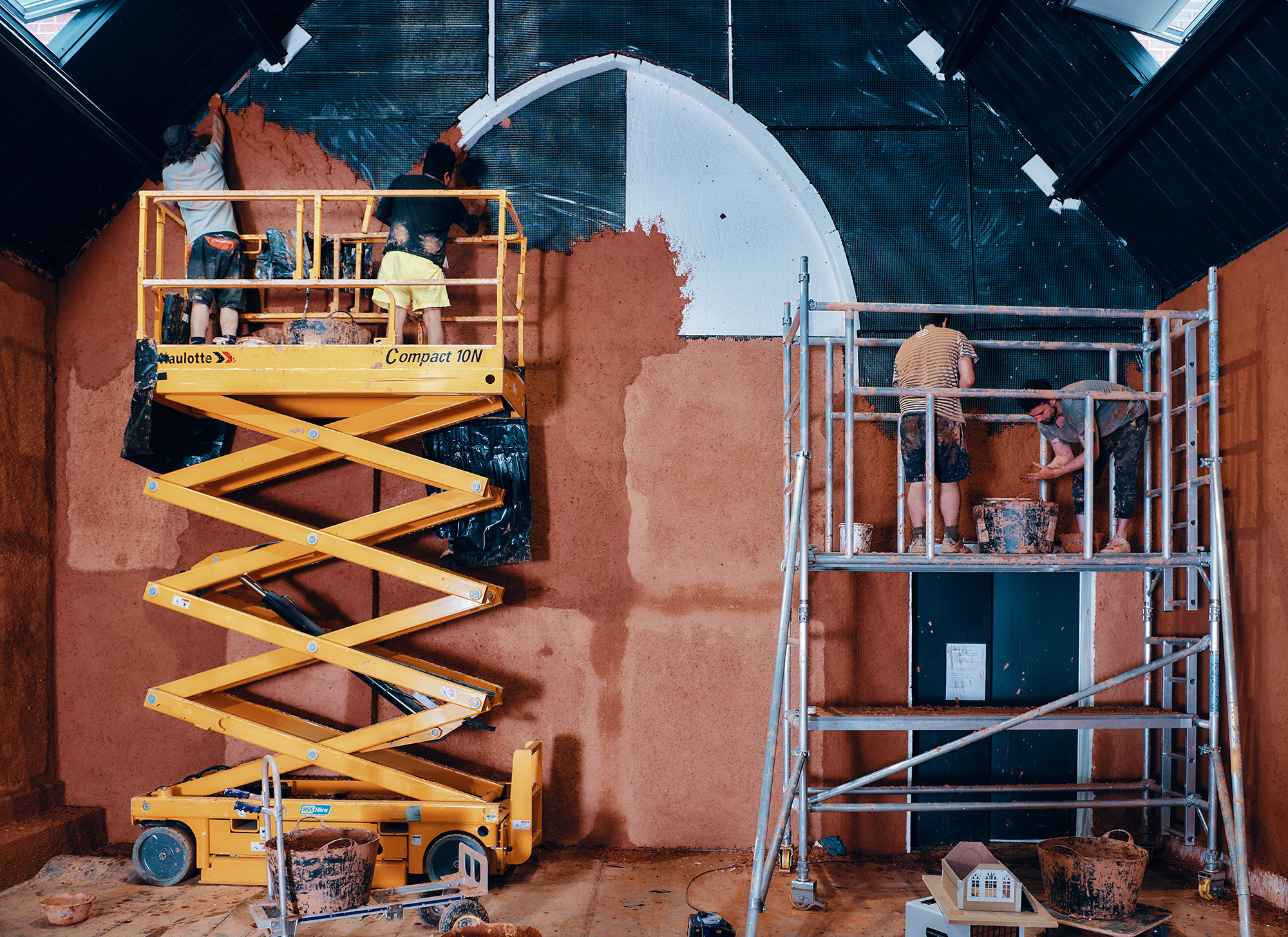


For the last month Lisbon-based Argentinian Chaile has been reimagining the space, transforming its ecclesiastical politeness into an earthy, textured, cave-like environment. A pre-fabricated mesh, measured to nestle within Studio Voltaire’s gallery, has nearly been completely built out with an clay over the last month, painstakingly applied by hand by Chaile and three associates – Tomás Bargao Henriques, Manuel Barros Brito, and Joaquin Biglione.
It’s a slow process – Chaile says that his shoulders ache after repeating the same movement over and over – but it’s clear watching the four work that there is a joy in completing such a task, perhaps in part because only a small patch of uncovered wall remains before the church interior has been entirely enclosed. The completed walls are a patchwork of earthen shades, different sections drying at different times as evidence of the durational aspect of the work, a uniform coarseness picking and playing the light.
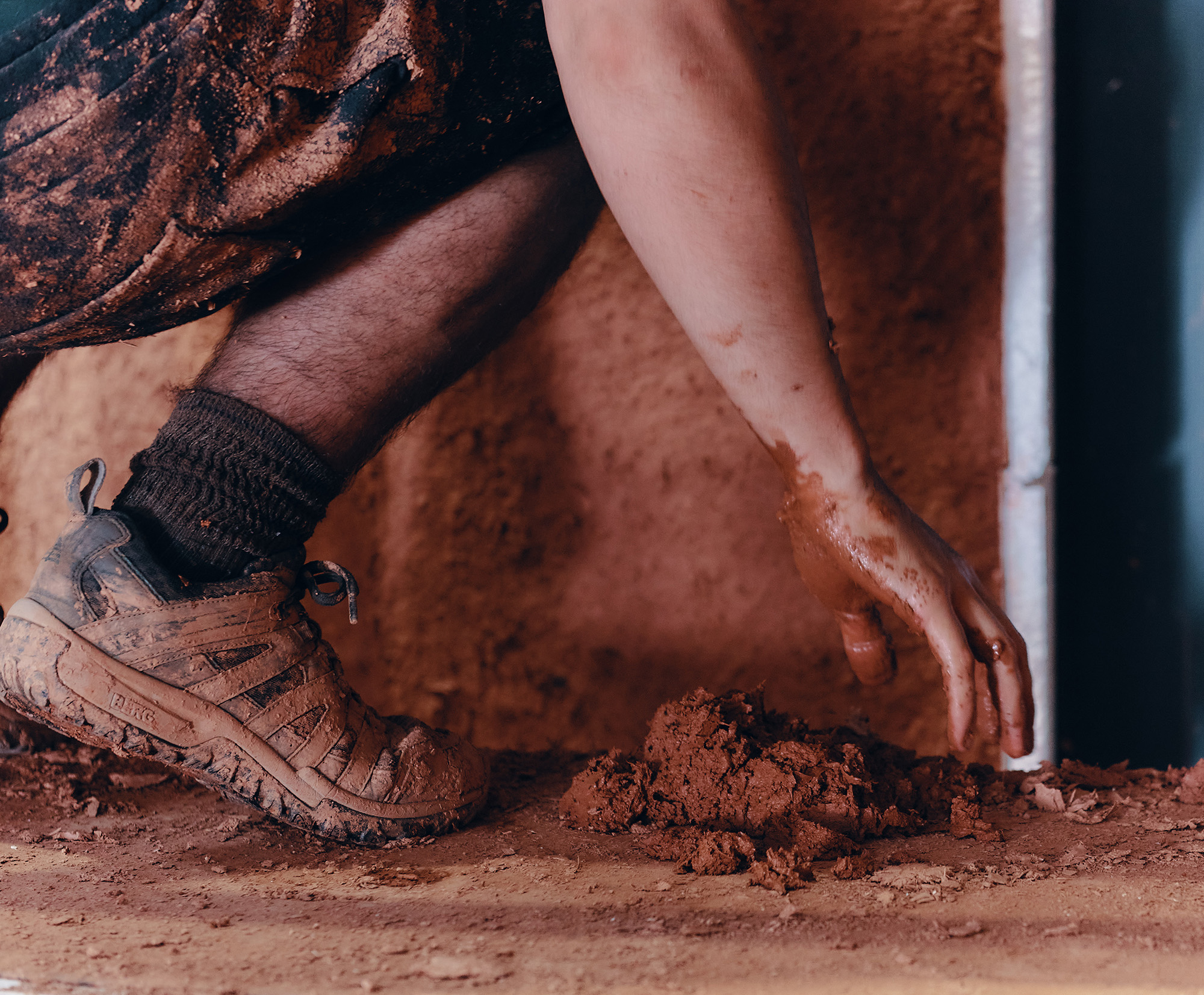


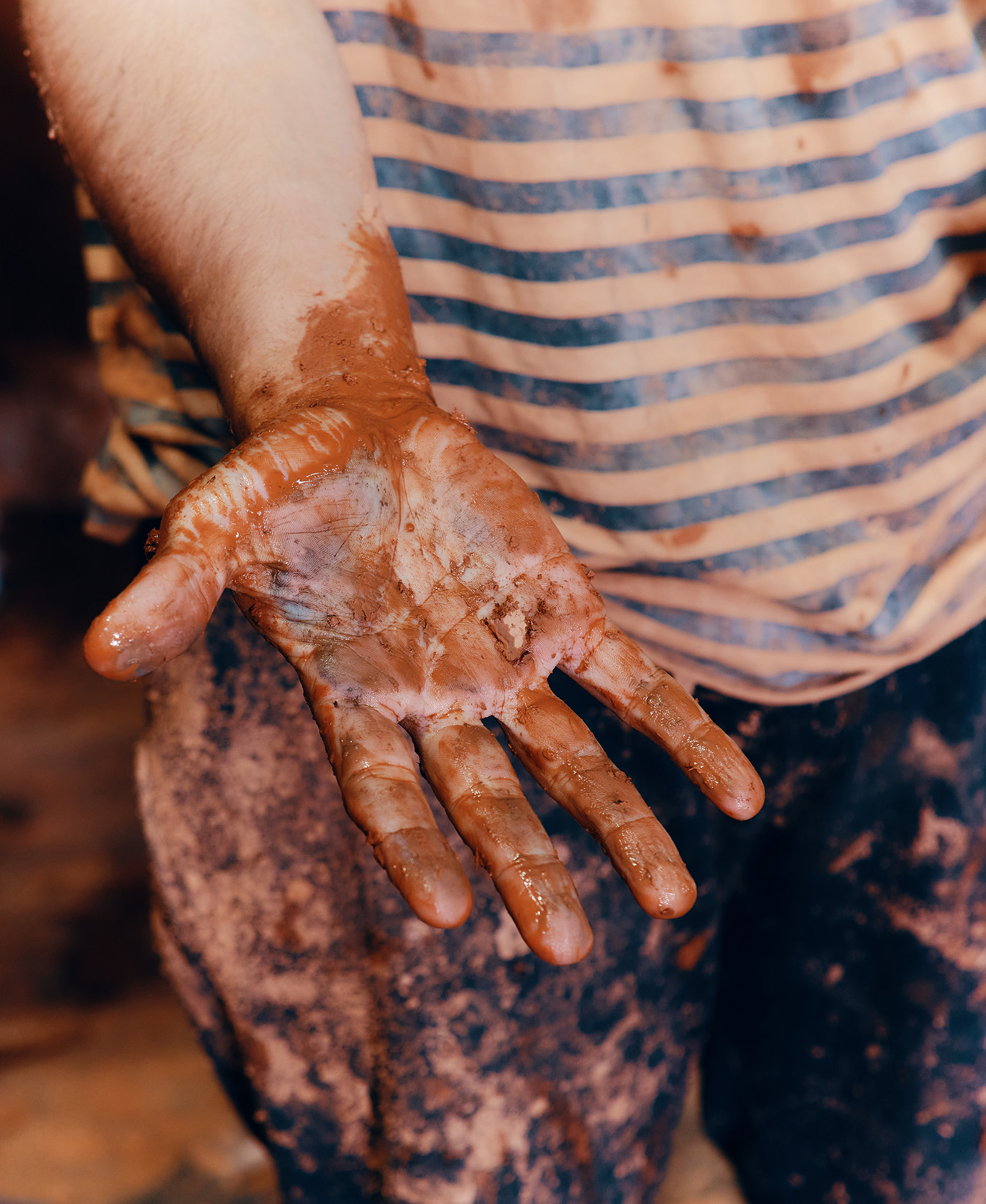
There is an attention to architecture in their process. Hands dive into the buckets of clay then take it up to gaps in the mesh, caressing the contours of the building and feeling its form with creative empathy. The result is an uncanny transformation of the space which is not only a contextual twist, but references compacted earth and adobe brick vernacular construction of houses and churches in northwest Argentina, where Chaile is from. Most earthen buildings in the region are colonial constructions dating from between the 16th and 18th centuries, with a number of examples which survived modernism having latterly been selected by the National Commission of Historical Monuments to be preserved and retained.
There is discussion, as noted in recent writing by Jorge Tomasi and Julieta Barada[1] , about how state intervention in the creation of a national historic identity homogenises the past, taking agency and control of nuanced and varied pre-national identities away from a local people. So, in Chaile’s craftsmanship of material and form, there is not only a borrowing of his territory’s aesthetic past, but the process of keeping it alive in new languages, new forms, and for new audiences – arguably a process of conservation which is not supported through a model of preserving historical monuments.
An approach to ethnography and craft is present across Chaile’s work. He has previously said that if not an artist he would have been a preacher or archaeologist, professions which both relate to the title of Studio Voltaire’s exhibition: Usos y Costumbres. Translating as Uses and Customs, it speaks to the idea of utilising traditional ritual and process for new modes of seeing and being.

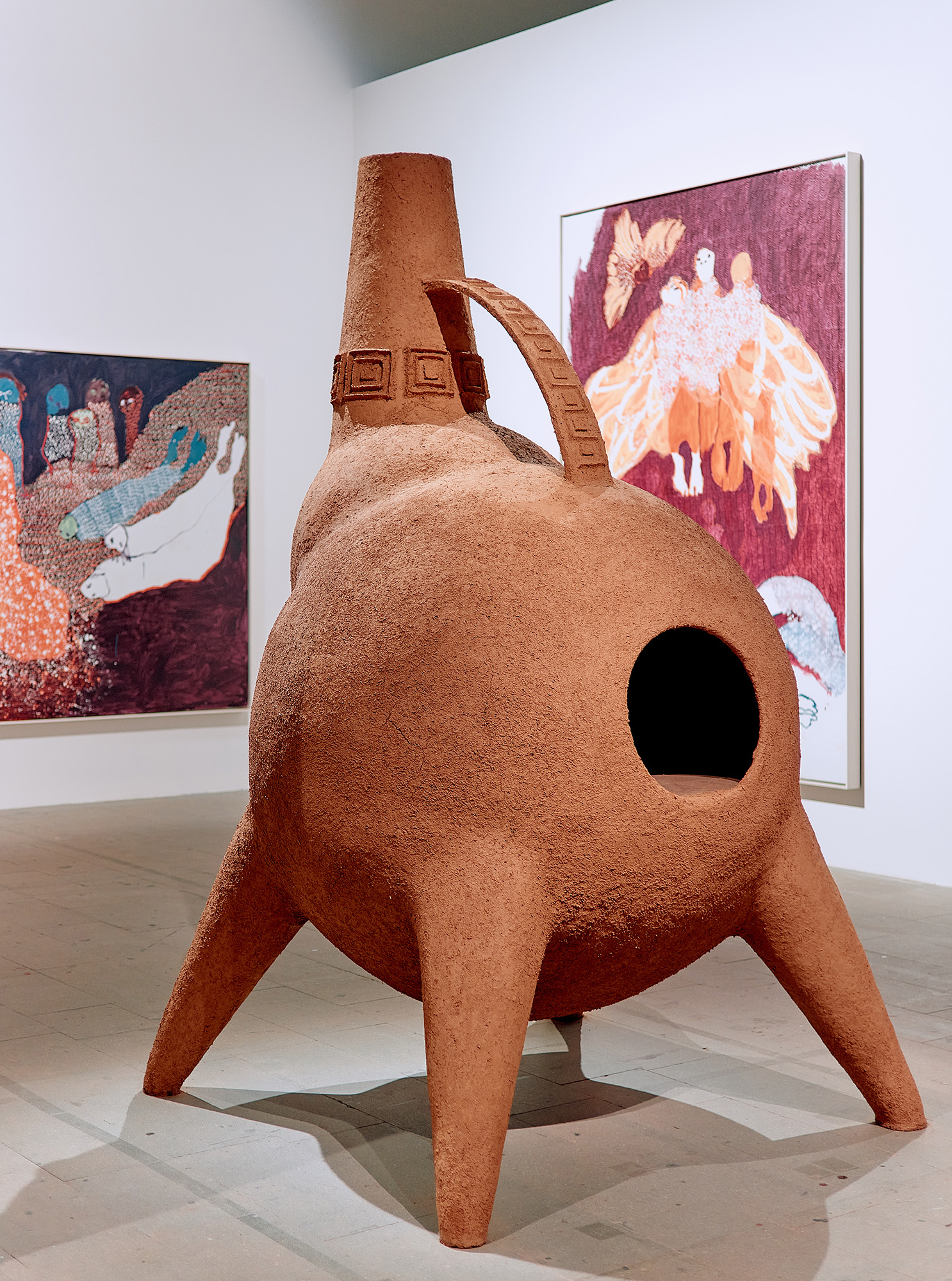



centre: Gabriel Chaile. right: Venice Biennale
Visitors to 2022’s Venice Biennale of Art may recall a group of five of Chaile’s clay sculptures – large forms which are part clay oven, part anthropomorphic form. They represented members of the artist’s family, drawing on not only personal memory but also descriptions passed down the generations through oral stories. Clay, memory, and story are all malleable and fragile, but also rich, tactile, and textured. Shaped into hollow vessels, and ones which carry the material of building and the communal act of cooking within its body, the dark voids within carry a memory of place, people, and culture.
Originally offered to Chaile as a solo exhibition, Usos y Costumbres features a second artist, Laura Ojeda Bär. Perhaps unusually within a competitive artworld, Chaile saw opportunity to share the opportunity and help a fellow Argentinian artist, with whom he has shown in numerous group shows, present their work to new audiences.



left: Laura Ojeda Bär
Hung over the top of the clay walls, some of Ojeda Bär’s paintings present what appear as concave windows, looking out from this imagined Argentinian mud building. Other paintings are drawn from a series started over lockdown. Trapped within her flat, the artist began to paint items discovered on art museum’s online archives. Pieces from various collections, genres, and histories mingle in a new, imaginary archive. Through translation from digital into painting the works take on new form, one which similarly reconsiders what is canon, where it is from, and through whose eyes we see it. Here, presented within an artspace which has had all its western conventions of whiteness, neatness, and uniformity lost to the gradual concealment under mud, we may reconsider them afresh.
The collaboration is more deeply articulated within two new works on show. Chaile says that an unfinished sculpture in the centre of the room is called Laura, after his fellow artist. While the largest of Ojeda Bär’s painting within the pre-hang is of Chaile – albeit deformed and mutated through an Instagram filter.




On one part of the wall, a simple curved line has been scored into the surface, offering a moment of geometry and clarity within the rough. Next to it, is some graffito, early tests by the artist of potential working into the walls once the last section of mesh has been filled in. These marks are suggestive of the most raw and primordial marks of human craft, of cave painting and simple shaping of earth’s elements. In a world of making and rethinking dominated by the digital, such a gestural return to raw form and matter is rich.
The muddy inner-shell of the church will stay in place for two months, slowly darkening and hardening into solid architectural skin. After, it will be cut into sections to match the mesh panels it is built into, carefully packed up and taken to Chaile’s studio in Lisbon – a city he was visiting on a residency when the pandemic struck and which has since become his base. Here, it is planned to rebuild the form of Studio Voltaire’s methodist church, a ghost of both the long architectural and shorter exhibition moments. A Victorian British church, deconsecrated into a contemporary art gallery, then reformed through historic South American craft and material, then finally relocated to colonial capital. It has the potential to become Chaile’s largest vessel yet, containing within it manifold composites of lives, stories, memories, and forms.

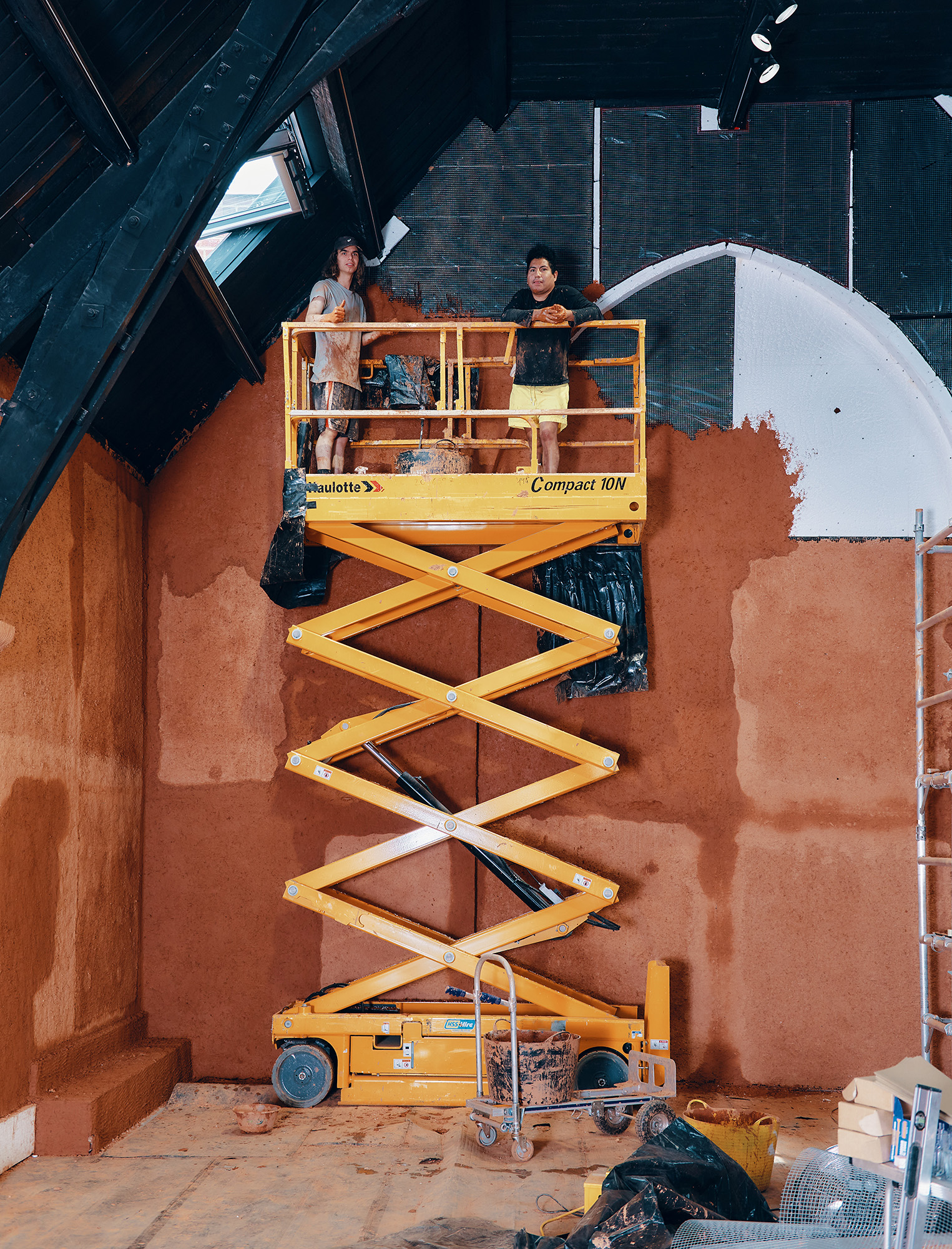
right: Gabriel Chaile & Laura Ojeda Bär with Tomás Bargao Henriques, Manuel Barros Brito, and Joaquin Biglione
[1] See: Tomasi, Jorge & Barada, Julieta (2021) The technical and the social: challenges in the conservation of earthen vernacular architecture in a changing world (Jujuy, Argentina). Built Heritage 5, 13. Availble at: www.built-heritage.springeropen.com/articles/10.1186/s43238-021-00034-w. <Accessed 10 July 2023>
Gabriel Chaile (b.1985, Argentina) lives and works in Buenos Aires and Lisbon. Chaile’s work has been exhibited at 5th New Museum Triennial, New York (2021); Foundation Thalie, Brussels (2021); Museum of Modern Art of Buenos Aires (MAMBA) (2017); Centro Cultural San Pablo T, Tucumán (2016); Centro Cultural Recoleta, Buenos Aires (2015); National Fund of Arts, Buenos Aires (2014); Centro Cultural Borges, Buenos
Aires (2011); New Energy Museum of Contemporary Art (the Ene), Buenos Aires (2011). In 2022, he participated in the 59th International Art Exhibition of La Biennale di Venezia. This is the first-ever institutional exhibition of his work in the UK.
Laura Ojeda Bär (b. 1986, Argentina) lives and works in Buenos Aires. She practises as an artist and independent curator. In 2019 Ojeda Bär took part in NES artist’s residency, Iceland, and Universidad Torcuato di Tella Artist’s Programs, Argentina. In 2020 she was commissioned by the InterAmerican Development Bank to produce new work for its Washington headquarters. Ojeda Bär’s works are held in private and public collections in Argentina, Mexico, Portugal, Brazil and the United States. Her works have been exhibited in Colección de Arte Amalia Lacroze de Fortabat, Buenos Aires (2022); Casa Nacional de Bicentenario, Buenos Aires (2022); Centro Cultural Recoleta,
Buenos Aires (2022); Moria Gallery, Buenos Aires (2022); Casa Argentina in Rome, Italy (2021); Fundación Tres Pinos, Buenos Aires (2019); Pasto Gallery, Buenos Aires (2016, 2015, 2013).
www.cargocollective.com/laura-o
Studio Voltaire is one of the UK’s leading not–for–profit arts organisations. Its pioneering public programmes of exhibitions, participation projects, live events and offsite commissions have gained an international reputation. The organisation has an outstanding track record of supporting artists at a pivotal stage in their careers, championing emerging and underrepresented practices and placing emphasis on risktaking
and experimentation. Many commissions are an artist’s first solo exhibition in London or the UK.
Exhibiting artists have included Aaron Angell, Nairy Baghramian, Phyllida Barlow, Monster Chetwynd, Anne Collier, Thea Djordjadze, Nicole Eisenman, Maeve Gilmore, Sharon Hayes, Nnena Kalu, Sanya Kantarovsky, Ella Kruglyanskaya, Shahryar Nashat, The Neo Naturists, Henrik Olesen, Paulina Olowska, Elizabeth Price, Charlotte Prodger, William Scott, Jo Spence, Cathy Wilkes and Rehana Zaman. Studio Voltaire commissions a wide range of participatory and offsite projects working in collaboration with artists, local organisations, schools and community groups and provides a much-needed resource of affordable and accessible onsite artists’ studios, supporting the development of diverse individual and collective practices, from recent
graduates to internationally recognised practitioners.
www.studiovoltaire.org
Buenos Aires (2022); Moria Gallery, Buenos Aires (2022); Casa Argentina in Rome, Italy (2021); Fundación Tres Pinos, Buenos Aires (2019); Pasto Gallery, Buenos Aires (2016, 2015, 2013).
www.cargocollective.com/laura-o
Studio Voltaire is one of the UK’s leading not–for–profit arts organisations. Its pioneering public programmes of exhibitions, participation projects, live events and offsite commissions have gained an international reputation. The organisation has an outstanding track record of supporting artists at a pivotal stage in their careers, championing emerging and underrepresented practices and placing emphasis on risktaking
and experimentation. Many commissions are an artist’s first solo exhibition in London or the UK.
Exhibiting artists have included Aaron Angell, Nairy Baghramian, Phyllida Barlow, Monster Chetwynd, Anne Collier, Thea Djordjadze, Nicole Eisenman, Maeve Gilmore, Sharon Hayes, Nnena Kalu, Sanya Kantarovsky, Ella Kruglyanskaya, Shahryar Nashat, The Neo Naturists, Henrik Olesen, Paulina Olowska, Elizabeth Price, Charlotte Prodger, William Scott, Jo Spence, Cathy Wilkes and Rehana Zaman. Studio Voltaire commissions a wide range of participatory and offsite projects working in collaboration with artists, local organisations, schools and community groups and provides a much-needed resource of affordable and accessible onsite artists’ studios, supporting the development of diverse individual and collective practices, from recent
graduates to internationally recognised practitioners.
www.studiovoltaire.org
visit
Usos y Costumbres, by Gabriel Chaile in collaboration with Laura Ojeda Bär, is showing at Studio Voltaire, London, until 10 September.
More information available at:
www.studiovoltaire.org/whats-on/gabriel-chaile-in-collaboration-with-laura-ojeda-bar
images
All images
©
Carlo Zambon: www.carlozambon.com
publication date
12 July 2023
tags
Adobe, Juliet Barada, Tomás Bargao Henriques, Manuel Barros Brito, Joaquin Biglione, Gabriel Chaile, Church, Clay, Craft, Earth, Will Jennings, Lisbon, London, Material, Mesh, Mud, Laura Ojeda Bär, Post-colonial, Scaffolding, Studio Voltaire, Jorge Tomasi, Venice Biennale, Carlo Zambon
More information available at:
www.studiovoltaire.org/whats-on/gabriel-chaile-in-collaboration-with-laura-ojeda-bar


